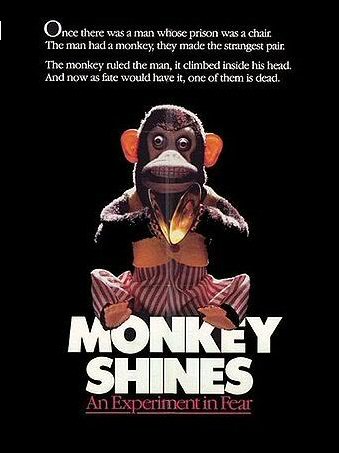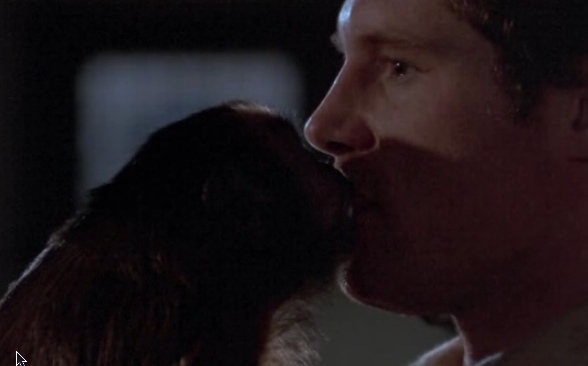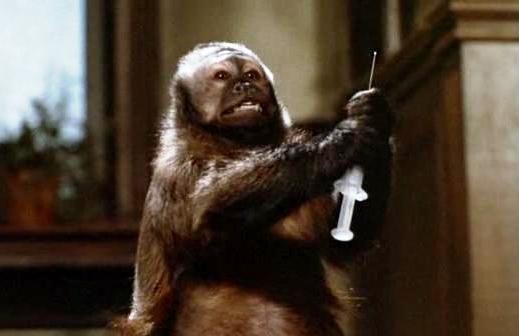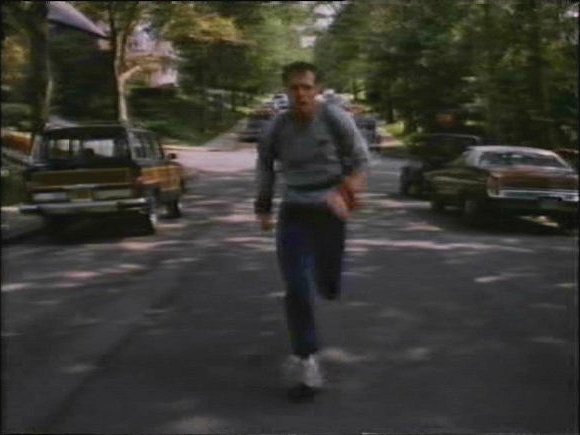
The late 1980s and ‘90s were not kind to George Romero. After the failure of DAY OF THE DEAD, the director made three studio films in a 15 year period before returning with the independently made BRUISER in 2000. The first of these was MONKEY SHINES. The film focuses on the relationship between a quadriplegic and his helper monkey, which turns sour out of jealousy as the monkey becomes psychotic and eventually takes to murder. Though it sounds far fetched, the premise makes for a good “jilted lover goes homicidal” tale with a twist. Sadly, MONKEY SHINES never quite lives up to what it could have been, nor to Romero’s earlier films.
Romero came into MONKEY SHINES well armed, with the novel written by Michael Stewart, and the backing of Charles Evans, the producer of the huge hit TOOTSIE. Romero adapted the novel, and brought to the film a good portion of his core group (DP Michael Gornick is the most notable absence, which I’ll discuss later). He assembled a decent cast that included Janine Turner, Joyce Van Patten and Stanley Tucci. Yet the sum of its parts never equal an enticing whole.
The plot revolved around Allan Mann, a successful law student with a beautiful fiancée. After some morning sex, Allan goes out for a run that will change his life. Hit by a truck, he undergoes surgery at the hands of the brilliant Dr. John Wiseman. Depressed and suicidal, his life turns around when his friend Geoffrey brings him a capuchin monkey to aid him. Ella takes a shine to him, and everything is great for a while. But Geoffrey didn’t divulge to Allan that Ella is so special because he’s been doing testing on her and other monkeys. She’s developed a super intelligence, but with it that worst of female traits, jealousy. At first, she turns her wrath on those who would do harm, including Wiseman, the fiancée and a nasty nurse (a gleeful, wicked performance by Romero’s then-wife, Christine). But as Allan’s feeling develop for monkey trainer Melanie, Ella becomes a danger to those he loves.
The greatest disappointment is that MONKEY SHINES does not feel like a Romero film. Going for a classic story about the psychotic lover who can’t handle a breakup, Romero eschews social commentary, the bread and butter on which he built his career. He could’ve made the film a statement on medicine, health care or our relationship with household pets, but instead he goes straight for the thriller aspect. And though it counts as a horror story, there’s barely any of Romero’s trademark gore. Tom Savini is on board essentially to make monkey heads with various facial tics. Aesthetically the film takes the biggest hit of all. Instead of relying mostly on steady shots and vigorous editing, Romero moves his camera all over the place. Sometimes this is to show Ella moving rapidly toward her next victim, but there’s movement in almost every other scene too. This was Romero’s first film in a long while without Michael Gornick as his director of photography, and as a result, MONKEY SHINES is distinctly not a George A. Romero film, stylistically speaking.
Also unlike most Romero films, MONKEY SHINES lacks a charismatic protagonist. As Allan, Jason Beghe is one-note, a slow burn screamer disgusted by life. Romero’s flicks are generally home to a lot of amateurish acting and histrionics, but Beghe is neither as enjoyably blowhard as Joe Pilato or as refined an actor as John Amplas. A better actor would’ve plumbed the wide range of a quadriplegic’s emotions, but Beghe just comes across as pissed off (and eventually pissed on). By comparison, the talented cast around him does no favors by pointing out his limited range.

The real star is Ella anyway. Played by Boo, a capuchin with an interesting story that Romero told on his episode of The Directors, Ella is likable at first. Allan’s friendly aide, she’s actually a lot more enjoyable to watch than Beghe is. When she starts to turn, the fun really begins. Ella is wicked like the best of scorned lovers, with some great facial expressions that make up for her inability to speak. Though it’s unlike Romero, the 1st monkey POV shots are a great credit to the film, and he does some nice camera tricks such as when a flame pops up and spreads across the lens. He also has form follow function, as the script develops a neat psychic link between Ella and Allan. And let’s facts, this is a rare movie where a monkey is the psychotic ex-lover. Ella steals the show, giving her best Glenn Close in FATAL ATTRACTION, and one-upping her.

On that note, it’s also nice to see Romero take a fresh angle on the whole fatal attraction scenario. From PLAY MISTY FOR ME through scores of Lifetime movies of the week, the formula is pretty basic, and varies little. Leave it to George to tweak it by finding some radical source material and bucking the trend. Hey, maybe this flick has a little Romero in it after all.
MONKEY SHINES was the first studio endeavor of a legendary maverick. Though it’s far from Romero’s best, it does enough with Ella to hold interest. After all, Hell hath no fury like a primate scorned.
-Phil Fasso
